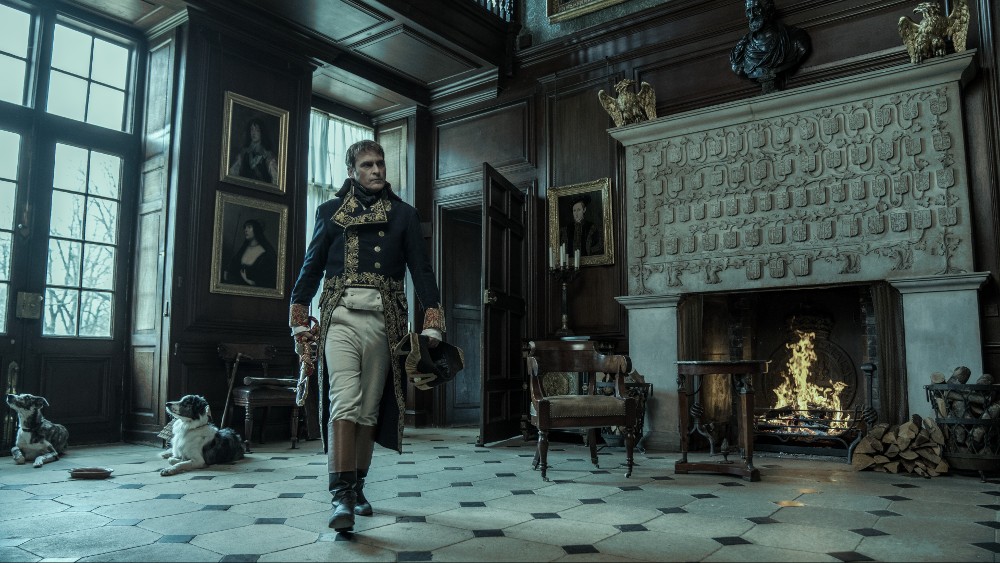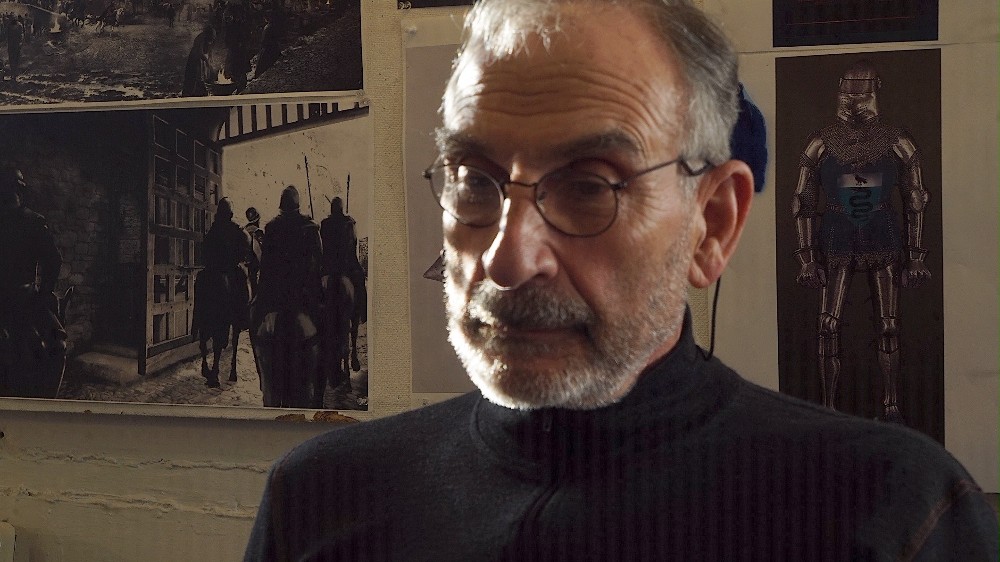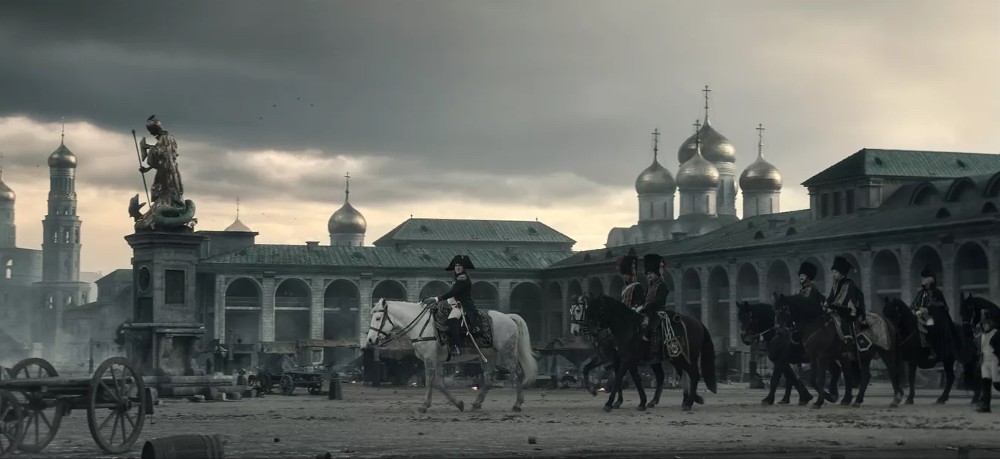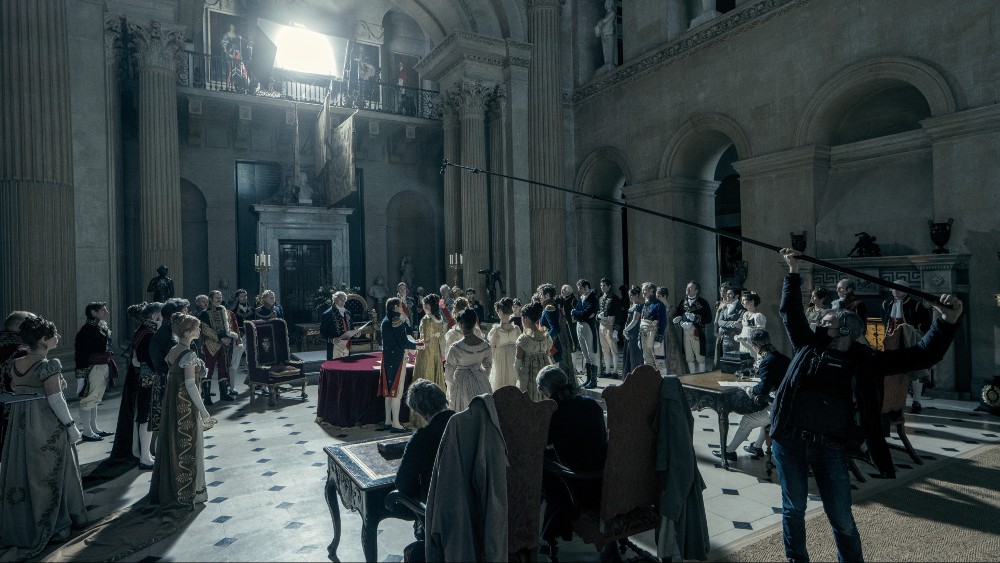
Ridley Scott has made many epic feature films with historical war dramas often being his regular stock-in-trade, and that continued to be the case with Napoleon, starring Joaquin Phoenix and Vanessa Kirby. While Scott has two bonafide stars for his latest film, the film’s look is just as much a star, many of the locations and scenes leave you with your jaw agape.
This is the 14th movie that Scott has done with Production Designer Arthur Max, a three-time Oscar nominee for previous work he’s done with the filmmaker, notably Gladiator, American Gangster, and The Martian. (Max’s first feature as a production designer was David Fincher‘s Se7en back in 1995.)
Max’s work included finding or designing all the movie’s historical locations, and for Napoleon, he reunited with Set Decorator Elli Griff, who worked with them both back in the early ‘00s for the Oscar-winning Best Picture Gladiator and for the follow-up, Blackhawk Down. She’s done a lot of different projects since then, including Guillermo del Toro‘s Hellboy: The Golden Army, Matthew Vaughn‘s The Man from U.N.C.L.E, as well as decorating that amazing set for Rian Johnson‘s Glass Onion a few years back, for which she was part of the winning team for an Art Directors Guild Award.
A few weeks back, Below the Line got on Zoom with the two art department heads to talk about what was involved with designing Napoleon vs. some of Ridley Scott’s other films on which they both worked.

Below the Line: Elli, I understand that this isn’t the first time you’ve worked with Arthur and Sir Ridley, but it’s been almost two decades. Is that right?
Elli Griff: It’s odd, isn’t it? I started with Arthur on Gladiator One in North Africa, and then I did Blackhawk Down, again in Morocco, and then I branched out for a quick flick with Tony to do Man on Fire. And then, I went off and raised a child and carried on working with different designers and dipped back for Napoleon. We have just touched base again on Gladiator 2 in Morocco, so I’m very lucky to have kept quite a lovely thread there with them.
BTL: Arthur, at what point over the years you’ve worked with him does Ridley mention Napoleon as a possible subject? Do you get hints it’s a movie he might want to make?
Arthur Max: From my point of view, he talked a couple of times, when [Stanley] Kubrick was around, and then, it never came to pass. Kubrick did a couple of years of research and compiled this enormous tome of research for the project, which is completely related. When we first started to do it – and it was in the press, as I remember that – everyone thought that we were picking up the project as a soldier on, on the field of battle, where Kubrick had dropped and fallen on his sword on the project, and we were picking it up, but that was completely untrue. Eli, did you look at the research book that was reprinted?
Griff: I did. I thought it was incredibly impressive, and helpful, actually, but of course, they went into the costume research in infinite detail, didn’t they? Golly. Drawing after drawing.
Max: Apart from that general research, it was completely unrelated to the story and the approach that Ridley and the writer took. The only thing in common really was Napoleon as a subject of the story. We’re great admirers of Kubrick’s work, but I think this was a completely original take on which [Ridley] approached the story.
BTL: When each of you got David Scarpa’s screenplay, what were some of the first things that jumped out that you needed to focus on, deal with, or figure out first if there’s anything… or everything?
Max: Everything is more like it.
Griff: I think every decorator approaches a job differently. There are no two decorators that work the same. For me, I wanted to get the flags and the horse dressing, and all those multiple elements that a lot of people don’t even realize that you’re generating and manufacturing. It’s to get them underway because the research is solid. It’s quickly unearthed and dictated, and we could just get on with it without having to break down and have meetings and stuff. That can start early. I tend to go with all those small basic elements first and get them out of the way.

BTL: What about yourself, Arthur?
Max: The biggest issue with me was the fact that we weren’t going to France to make a film about France’s most illustrious historical character. Once I got over that fact, the challenge then became finding France in England. For a lot of the bigger scenes and interiors, particularly. We found a few in Malta, interiors, but mostly Malta was for the nautical side of the story. The Battle of Toulon, the exile to Elba, and ultimately, the re-exile back to St. Helena, because it’s an island. It had a magnificent harbor of the period, and it had dock and port facilities, which lent itself to the story.
[Malta also has] a nascent film industry where we had worked before, so we knew it. I think that was the basic motivation for not going to France, and trying to find what we could of France elsewhere. That was the biggest challenge, I think. I think we did okay. Architecturally, there’s a lot to offer in the stately homes of England. We also did Russia, we did Austria. In the original script, we crossed the Alps, invading Italy. We did Italy a bit, but I don’t think it made the film.
We had to give up a few big scenes and sequences that we had worked on, but that’s filmmaking, and that’s filmmaking with Ridley, because the canvas is enormous, the brushes are large, but there’s also the fine detail and the macro side of things, and to make that world live, however large it is.
BTL: I spoke to Dariusz for The Last Duel; wasn’t that movie shot in France?
Max: A major part of it was, yes, but that’s because a lot of the 12th Century still exists there, whereas there’s not so much an impact of that era in England. You go where you think the riches are, where the precious metal vein is largest for what you’re looking for. We’re prospectors in history, so it’s horses for courses.
Every film is a bit of a prototype, so you kind of examine her on that level. Where can you get the best interiors, exteriors, landscapes. Also, there’s a business side of filmmaking these days, with economic benefits that different countries offer to filmmakers. Crew bases is another factor and accommodations for large crews when you’re talking about a crew of 300-plus, where you’re going to put them all is a factor.
I think we did okay. There was enough available in England to be authentic to the period and have the ability to recreate not only France, but Russia and Austria, Italy, as well.

BTL: When you’re first sitting down and breaking down the script, are you figuring out what you can build on a soundstage for interiors, or even having discussions about what might be done by visual effects? How are you deciding that during the early stages?
Max: That’s a roundtable discussion with the heads of all the departments at a great big table setting, called the “War Room,” very apt in the case of Napoleon. You talk it over, and everybody’s there, whether they’re physically there, and don’t forget, we were in the time of COVID, during the planning stages, so a lot of people weren’t there, they were on Zoom. And then, you get into what Ridley wants to achieve.
As the script is evolving, your designs and your locations are evolving at the same time. It’s a combination of things with all departments chipping in. He does his famous storyboards – “Ridleygrams” they’re called – so you have a very clear idea of how he conceives sequences visually, and what the elements are.
It’s a process of refinement over time. Usually, we don’t have a lot of time, and the refinement is pretty well, as you’re in pre-production, and scripts evolve, location possibilities evolve, and you stay light on your feet. Don’t you, Elli?
Griff: Yeah, for sure. Because you don’t actually know what’s gonna hit you next, outside what you’ve got planned, but you have to be prepared.
Max: To be able to shift gears really quick.
Griff: I certainly get a buzz from being able to solve immediate asks very quickly. I think you only get that from years and years of experience, so it’s a delight to work easily and quickly with a team of people.
BTL: Elli, how early are you involved with something like this? Are you doing research right from the beginning, or do you need to have the actual spaces to dress, at least for interiors?
Griff: You have to wait for things to shape, then formulate, but obviously, there are always things that I can get on with very, very quickly. Once a location becomes semi-confirmed, then it becomes very clear what I have to do and what I have to present to my designer, and the director in terms of making a coherent conversation about an environment, until you have that environment.
It’s a bit like you’re working in the theater, really. I have to put in all the elements, and then wait for the four walls and the wings – I have to wait for that to come in, because if we wait for everything, then we’ll never hit the target. I try to forge ahead as much as I can with a broad strokes.
Max: Elli, she really comes in at the very end of a lot of processes. If we have locations, very often they’re not confirmed until the last minute, and they come back with a lot of contract clauses that limit what we can or can’t do. She’s really on the tail end of that process and has a lot to achieve in a short period of time. So you have to commit to your ideas, and then kind of fit them into the limitations of what you have to work in.

BTL: From Napoleon’s times, are there paintings so you can figure out what the interiors look like, or do you just use your imagination based on the stuff that’s out there for research?
Griff: While I love research – history is my thing, really, and I have an extensive library, luckily, at home – I do believe in going to experts and museum departments and seeking out their boffins. It’s so rewarding to get the finer details and the smell of environments that you might miss out on if you didn’t just pursue the odd conversation here and there with an expert. I’m lucky to have that in my hands, and I do rely heavily on that research.
But also, if I come across something that I think is appropriate or might be useful to standby on that particular set, then I will include that and offer it up as an alternative or suggestion. But it’s all deeply rooted in period research on a film like this. For example, when we were in another location for his coronation, that was the [Jacques-Louis] David painting of the coronation. It was rewarding when they pull back, and there were static shots that reminded you of the painting. They were so faithful to that, it was a real buzz to realize that we’d actually achieved it. The colors, the textures, the lights, the costume is, of course, but yes, we absolutely claimed that one, and that could have been impossible just because of the sheer height and breadth of the painting and the set.
BTL: What about yourself in terms of research, Arthur?
Max: I just know a researcher, an English lady who lives in Paris and does research and has access to the Bibliotheque Nationale in Paris. I just sent her lists and lists of subjects, and she sent me tons and tons. We had an encyclopedia in the art department of research from her, and then as the script evolves, you get little bits of detail out that come up, and you update as you go. On the other hand, as Elli was saying, we look at the historical paintings, sometimes emulating them exactly, if that’s the conceit that Ridley thinks is the right way to approach it.
We had a character in the coronation, who was sketching the scene, who was Jacques-Louis David himself, and then we go to his studio for another scene. We recreated a studio where part of the painting is being painted by the painter, as a conversation with Napoleon is going on, while he’s sitting, watching the painting of his coronation being made, so it’s very intertwined. On the other hand, there are other scenes where it’s complete fantasy and fiction, made up for dramatic purposes, and have nothing to do with history, because it’s not a documentary we’re making. We kind of run the gamut of all of those bits of research that we do — we sometimes just throw them away completely.
Napoleon is now available on VOD.





